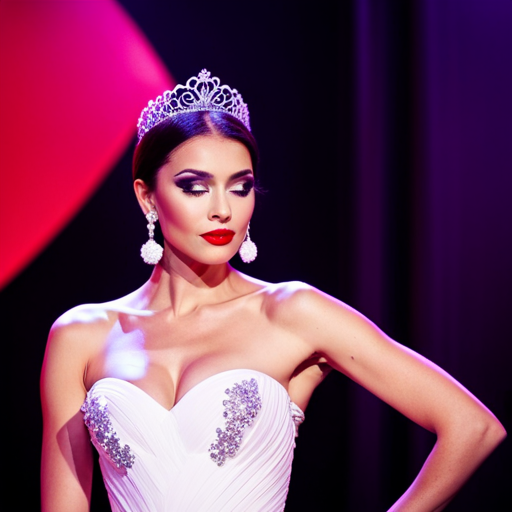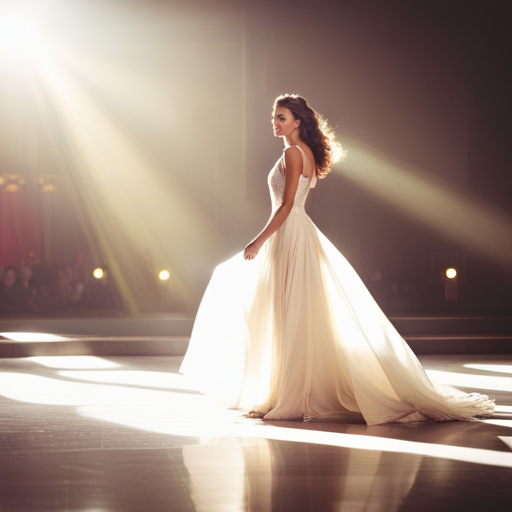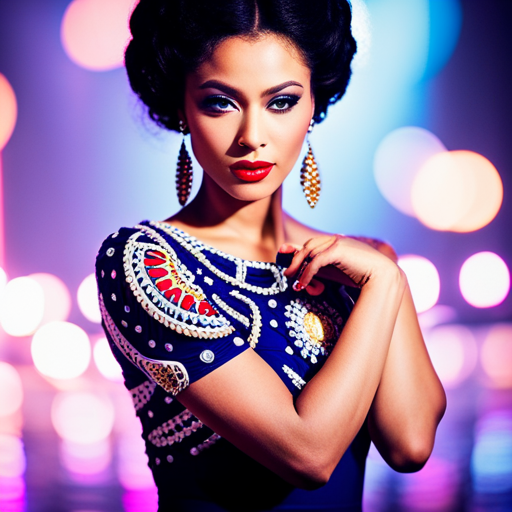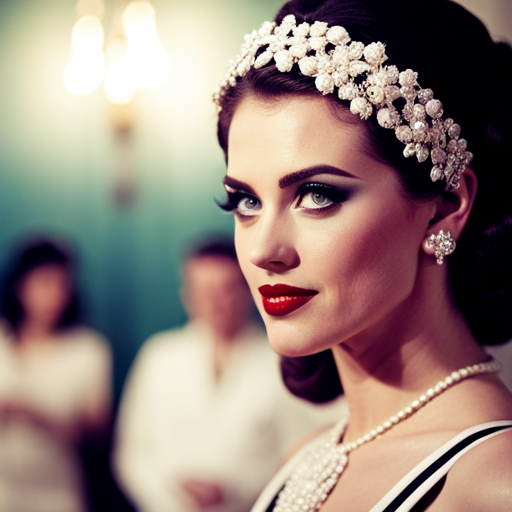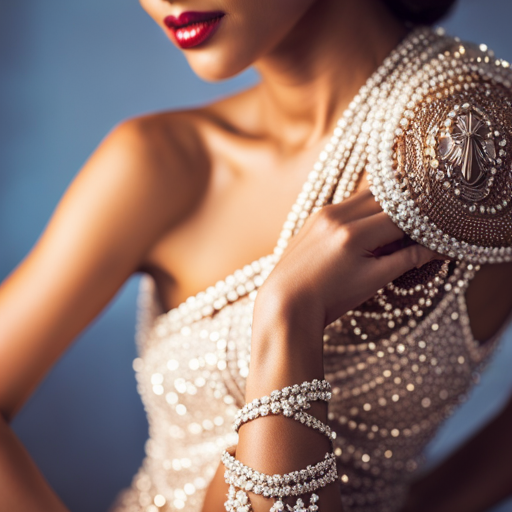Iconic Pageant Outfits and Their Stories

Step into the captivating world of pageantry as we delve into the stories behind some of the most iconic outfits in beauty pageant history.
From ethereal evening gowns to groundbreaking talent ensembles, these garments have left an indelible mark on the global stage.
Join us as we uncover the intricate details, cultural significance, and the remarkable journeys of the women who wore these mesmerizing creations, each embodying grace, poise, and elegance.
Miss Universe 2005: Natalie Glebova’s Ethereal Evening Gown
In 2005, Natalie Glebova captivated audiences with her ethereal evening gown at the Miss Universe pageant. Glebova’s impact was profound as she gracefully glided across the stage, exuding elegance and sophistication.
The gown, designed by renowned fashion designer Sherri Hill, was a masterpiece of ethereal design, featuring delicate layers of chiffon that seemed to float around Glebova as she moved. The soft pastel color enhanced her natural beauty, accentuating her poise and confidence.
Glebova’s choice of attire not only showcased her individual style but also set a trend for future pageant contestants. The ethereal gown became synonymous with her reign as Miss Universe, inspiring a new wave of ethereal designs in pageantry. Its influence extended beyond the pageant world, impacting the fashion industry as a whole.
The ethereal evening gown worn by Natalie Glebova in 2005 continues to be celebrated for its timeless beauty and the lasting impact it had on pageant fashion. Its legacy is a testament to the power of a well-chosen outfit in creating a lasting impression and setting trends.
Miss America 1984: Vanessa Williams’ Groundbreaking Talent Outfit
Vanessa Williams’ groundbreaking talent outfit in the 1984 Miss America pageant captivated audiences with its innovative design and performance impact. At a time when ethnic diversity in pageants was not widely celebrated, Williams, as the first African American woman to win the Miss America title, made a profound statement with her talent outfit.
The outfit seamlessly blended elements of her African heritage with modern fashion, showcasing a fusion that reflected the evolving cultural landscape. The ensemble not only displayed her vocal prowess but also symbolized a shift in the pageant world towards embracing a more inclusive representation of beauty and talent.
The outfit’s impact went beyond the stage, sparking conversations about the need for greater diversity and representation in pageantry and the fashion industry at large.
Vanessa Williams’ talent outfit marked a pivotal moment in the fashion evolution of pageantry, setting a precedent for future contestants to celebrate their individual heritages through their attire and performances. This shift towards embracing diversity and cultural representation would continue to influence pageants and fashion, shaping the way contestants express their unique identities on stage.
This commitment to inclusivity would be further exemplified in subsequent pageants, such as Miss World 1994, where Aishwarya Rai’s regal saree would redefine traditional beauty standards.
Miss World 1994: Aishwarya Rai’s Regal Saree
With what grace and significance did Aishwarya Rai’s regal saree redefine traditional beauty standards at the Miss World 1994 pageant? Aishwarya Rai, representing India, captivated the audience with her elegance and cultural representation through the timeless Indian attire. The significance of her pageant saree went beyond just being a stunning outfit; it marked a pivotal moment in the influence of Indian fashion on a global stage.
Here’s why Aishwarya Rai’s regal saree at Miss World 1994 was so iconic:
-
Aishwarya Rai’s elegance: Her poised demeanor and the way she carried herself in the intricately designed saree showcased grace and sophistication, leaving a lasting impression on the audience and judges alike.
-
Indian fashion influence: The regal saree not only highlighted Aishwarya’s beauty but also brought attention to the rich heritage and craftsmanship of Indian textiles and traditional attire.
-
Pageant saree significance: Aishwarya Rai’s choice to wear a saree at an international pageant challenged the conventional norms of beauty and brought forth a new perspective on elegance and style.
-
Cultural representation in pageants: Aishwarya’s saree became a symbol of pride for many, as it represented the celebration of diversity and cultural representation in global beauty pageants.
Miss Universe 2015: Pia Wurtzbach’s Crown-Winning Evening Gown
Pia Wurtzbach’s crown-winning evening gown at Miss Universe 2015 continued the trend of using iconic outfits to symbolize cultural representation and redefine beauty standards in international pageants. Wurtzbach’s impact was not only felt through her historic win as the third Filipina to win the Miss Universe title but also through her choice of evening gown, which showcased her elegance and grace. The gown, designed by Albert Andrada, featured intricate details that highlighted the craftsmanship and artistry of Filipino designers. The gown’s sweetheart neckline and fitted bodice accentuated Wurtzbach’s figure, while the flowing silk chiffon fabric added a touch of glamour as she glided across the stage. The intricate Swarovski crystals and pearls embellishing the gown reflected the rich cultural heritage of the Philippines. Wurtzbach’s choice of a Filipino-designed gown not only celebrated her roots but also brought attention to the talent and creativity of Filipino fashion designers on the global stage.
| Design Details of Pia Wurtzbach’s Evening Gown | ||
|---|---|---|
| Designer | Albert Andrada | |
| Neckline | Sweetheart | |
| Fabric | Silk chiffon | |
| Embellishments | Swarovski crystals, pearls |
Miss Earth 2001: Winfred Omwakwe’s Nature-Inspired National Costume
Continuing the trend of using iconic outfits to symbolize cultural representation and redefine beauty standards in international pageants, the nature-inspired national costume worn by Winfred Omwakwe at Miss Earth 2001 showcased her connection to the environment and celebrated the beauty of nature. This iconic national costume embodied the essence of nature-inspired fashion and held significant cultural importance.
The nature-inspired national costume embodied the following elements:
-
Flora and Fauna: The costume featured intricate designs representing the diverse flora and fauna of Kenya, paying homage to the country’s rich natural heritage.
-
Earthly Elements: Omwakwe’s attire incorporated earthy elements such as leaves, flowers, and natural materials, symbolizing the harmony between humans and nature.
-
Cultural Symbolism: The costume was adorned with traditional Kenyan motifs, reflecting the cultural significance of national costumes in representing a contestant’s heritage on an international stage.
-
Environmental Advocacy: This attire not only represented Omwakwe’s connection to nature but also served as a platform to advocate for environmental conservation, aligning with the Miss Earth pageant’s focus on environmental awareness and sustainability.
Winfred Omwakwe’s nature-inspired national costume not only showcased her pride in her Kenyan heritage but also highlighted the cultural significance and environmental advocacy intertwined in pageantry.
Miss International 2018: Mariem Velazco’s Elaborate Evening Gown
Mariem Velazco’s Elaborate Evening Gown at Miss International 2018 captivated audiences with its exquisite design and intricate details. The gown, designed by Venezuelan designer Gionni Straccia, showcased elaborate designs that were inspired by Velazco’s cultural heritage. The gown featured a fitted silhouette with a plunging neckline and a dramatic, voluminous skirt. The bodice was adorned with intricate hand-embroidered patterns that drew inspiration from traditional Venezuelan textiles and craftsmanship. The rich, vibrant colors of the gown, including deep reds and golds, reflected the cultural influences of Velazco’s homeland.
The elaborate evening gown not only highlighted Velazco’s grace and poise but also served as a representation of her Venezuelan roots on an international stage. The fusion of traditional elements with modern design techniques resulted in a gown that was both visually stunning and culturally significant. Velazco’s choice to wear this elaborate gown not only celebrated her heritage but also provided a platform to showcase the artistry and craftsmanship of Venezuelan designers. It was a testament to the beauty and diversity of global cultures that are often showcased in pageantry.
Frequently Asked Questions
What Material Was Used to Make the Evening Gown Worn by Natalie Glebova at Miss Universe 2005?
The evening gown worn by Natalie Glebova at Miss Universe 2005 was crafted from luxurious silk chiffon. Glebova’s choice of material exuded elegance and sophistication, contributing to the impact of her pageant outfit, reminiscent of Vanessa Williams’ iconic style.
How Did Vanessa Williams’ Groundbreaking Talent Outfit Impact Future Miss America Pageants?
Vanessa Williams’ groundbreaking talent outfit at the Miss America pageant had a significant impact on diversity and cultural representation. By showcasing her talent, she broke barriers and paved the way for greater inclusivity in future Miss America pageants.
What Was the Significance of Aishwarya Rai’s Choice to Wear a Saree at Miss World 1994?
Aishwarya Rai’s decision to wear a saree at Miss World 1994 was a cultural statement that resonated globally. Her choice celebrated Indian tradition and redefined beauty standards, making a significant impact on fashion and cultural representation.
How Did Pia Wurtzbach’s Crown-Winning Evening Gown Reflect Her Personal Style and Personality?
Pia Wurtzbach’s crown-winning evening gown reflected her personal style and personality through its elegant silhouette and intricate embellishments. The gown showcased her sophisticated fashion influence and exuded confidence, capturing the essence of her identity on the pageant stage.
What Was the Inspiration Behind Winfred Omwakwe’s Nature-Inspired National Costume at Miss Earth 2001?
Winfred Omwakwe’s nature-inspired national costume at Miss Earth 2001 was a stunning display of creativity and ingenuity. The intricate design and use of eco-friendly materials reflected a deep respect for the environment and showcased his commitment to sustainability.
Conclusion
In conclusion, these iconic pageant outfits have left an indelible mark on the world of beauty and fashion. Each outfit tells a unique story and holds a special significance in the history of pageantry.
From groundbreaking talent outfits to regal evening gowns, these outfits have stood the test of time and continue to inspire future generations of pageant contestants. They truly embody the saying, ‘standing the test of time,’ as they remain influential and memorable years after their debut.
